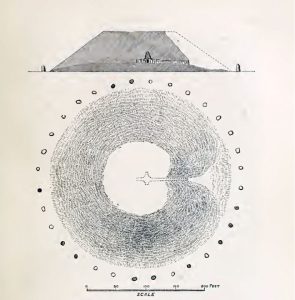3
Irish Archeology
“By its nature, archaeological evidence is of limited value in reconstructing belief systems or mythological narratives, but it does seem that at least some Irish population groups set up anthropomorphic wooden or stone images that may be of gods. One found in the bog of Ralaghan, Co. Cavan, is roughly a metre long and made from a single round trunk of yew: it has a gouged hole in the genital area, which may once have held a carved phallus. . . . [S]imilar sculptures have turned up sporadically in Britain in a more explicitly Iron Age context, suggesting that they may once have been widespread” (Williams 6).
MY first bog idol was Ralaghan Man in the NMI. It was love at first sight. Made of yew, dating to the late Bronze Age, he's an odd fellah. People thought it was female as there was a hole gouged in the pubic area, but in fact, it's more likely a wooden John Henry fitted there pic.twitter.com/SlJZZsC7bL
— (Dr) Rena Maguire (@justrena) April 28, 2018
Sheela-na-gigs
“Sheela-na-gigs are carvings of female images depicted as posing in a manner which accentuates that most powerfully evocative symbol the vulva. They are primarily a sacred religious object that was erected on many churches of the medieval period, invariably placed in a very prominent position such as over the main entrance door or a window. . . . Sheela-na-gigs probably originate sometime in the early Christian era but the history of the tradition is hotly disputed. It is clear however that the use of the image spread widely after the 12th century reaching a zenith during the later medieval period. . . . The image of the goddess in her hag form occurs frequently in mythology and they are generally regarded as a grotesque, older woman possessed of supernatural powers. In the story of Da Derga’s Hostel, the hag curses the king who refuses her entry by, ‘standing on one leg with one hand held up in the air,’ a stance taken by a number of Sheela.” (Roberts, Jack. The Sheela-na-gigs of Ireland: An Illustrated Map & Guide, Bandia Publishing, 2009.)

Newgrange, Boyne Valley
A History of Ireland in 100 Objects: https://100objects.ie/objects/
| #2: Ceremonial Axehead | #16: Armlet, Old-Croghan Man |
| #3: Neolithic Bowl | #17 Loughnashade Trumpet (Cahill 79) |
| #4: Flint Macehead | #18: Keshcarrigan Bowl |
| #7: Pair of Gold Discs | #19: *Corleck Head |
| #8: Coggalby Gold Hoard | #22: St. Patrick’s Confessio |
| #9: Bronze Age Funerary Pots | #23: Mullaghmast Stone |
| #10 Tara Torcs (Cahill 79) | #24: St. Patrick’s Bell |
| #11: Mooghaen Hoard | #26: Ballinderry Brooch |
| #12: Gleninsheen Gold Gorget | #27: Book of Kells |
| #13: Castlederg Bronze Cauldron | #29: Tara Brooch |
| #14: Iron Spearhead | #30: Ardagh Chalice |
| #15: Broighter Boat |

